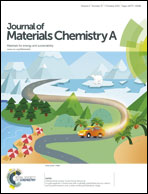Oxygen permeation behavior through Ce0.9Gd0.1O2−δ membranes electronically short-circuited by dual-phase Ce0.9Gd0.1O2−δ–Ag decoration
Abstract
Electronically short-circuited ion conducting fluorite membranes for air separation are a relatively novel category of ceramic membranes overcoming the long-standing stability problem of the state-of-the-art perovskite membranes under reducing and acidic conditions. Such robust membranes have particular potential to further improve the economics of clean energy projects and syngas production. In this work, we adopted the conventional dual-phase membrane idea to decorate the fluorite membrane surface. Previously, a pure noble metal layer was employed as an electronic decoration layer which displayed several limitations. In this work, instead, a dual-phase mixture of Ce0.9Gd0.1O2−δ (50 wt%)–Ag (50 wt%) was applied as the decoration layer of the Ce0.9Gd0.1O2−δ bulk membrane. Such a strategy not only reduces the material cost and enhances the interface adherence but also significantly improves the O2 flux rates as more triple-phase boundary area is created for surface O2 exchange reactions. We further confirm the stability of the resultant short-circuited Ce0.9Gd0.1O2−δ membrane during the 130 hour permeation test at high temperatures under a CO2 containing atmosphere.


 Please wait while we load your content...
Please wait while we load your content...